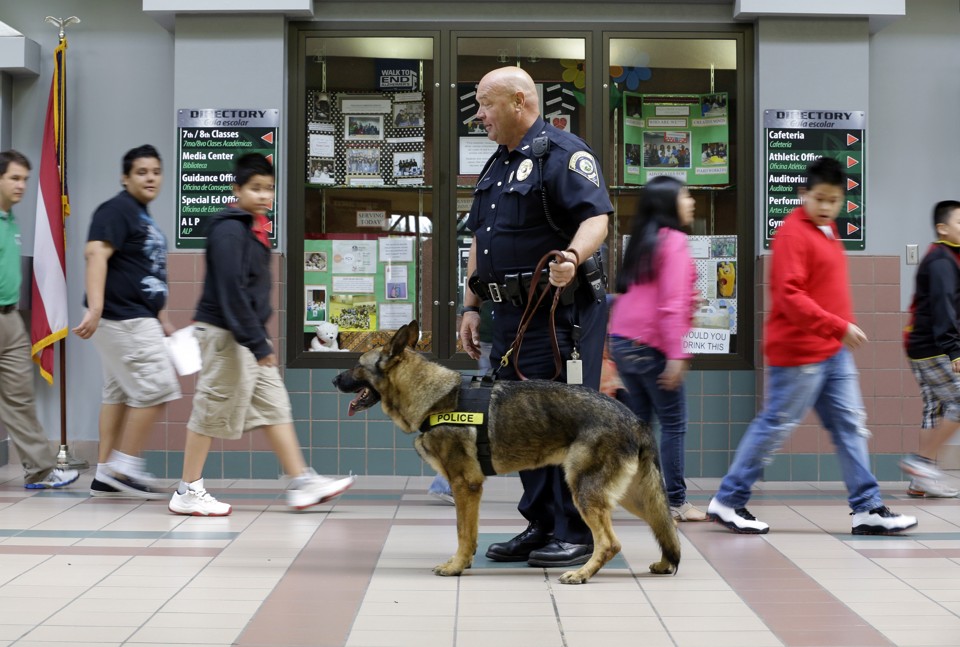When Schooling Meets Policing
Thousands of sworn law-enforcement officers are posted at U.S. public schools. What does that do to campus culture?

A Lawrence Police Department officer walks a narcotics dog down a school hall in Indianapolis.Michael Conroy / AP
The events have grabbed headlines and public attention, sparking what are now all too familiar debates in the United States about police overreach. In Raleigh, North Carolina, a water-balloon fight at Enloe High School, initiated as a senior-day prank, ended with eight teens arrested and two dozen police officers dispatched to the campus “to restore order.” When a Virginia 4-year-old with ADHD threw a temper tantrum in his prekindergarten classroom late last year—allegedly throwing blocks and hitting and kicking his educators—the school’s principal, according to reports, summoned a deputy assigned to the school, who then handcuffed the child and transported in a squad car to the sheriff’s office. And in a recent episode whose news has since gone viral, a Texas, teen with a keen interest in gadgets built a clock, took it to school to show his teacher, and was sent to juvenile detention when police mistook his device for a bomb.
The details of each of these and other cases vary, but the results have largely been the same. In settings where schooling and policing intersect, the disciplining of students—often for behavior as innocuous as school-age pranks or ascommonplace as temper tantrums, and in some cases including children who are so young they still have all their baby teeth—can extend beyond the purview of principals and school staff to law-enforcement who have little to do with education. Data suggests that this is a growing and, for some, disconcerting trend.
The details of each of these and other cases vary, but the results have largely been the same. In settings where schooling and policing intersect, the disciplining of students—often for behavior as innocuous as school-age pranks or ascommonplace as temper tantrums, and in some cases including children who are so young they still have all their baby teeth—can extend beyond the purview of principals and school staff to law-enforcement who have little to do with education. Data suggests that this is a growing and, for some, disconcerting trend.
Estimates reported by The New York Times in 2009 indicated that as many as17,000 sworn police officers were posted in U.S. schools at the time, and federal data included in a National Center of Education Statistics report offers a closer look at the characteristics of campus-based police. According to the report, a little over three in four high schools and the vast majority of large schools (those with 1,000 or more students) have armed security staff, with only a slight statistical difference between urban and suburban areas. But there is great variation based on race and class: Schools where at least half of the children are nonwhite, as well as high-poverty schools (meaning those where at least 75 percent of students are eligible for free or reduced-price lunch) are home to the highest percentages in the country of K-12-campus law enforcement.
The origin of school-employed police—who are often officially referred to as “school resource officers” (SROs)—dates back to the 1950s. It arose as part of an The Importance of Examining Schooling Policing in the Aftermath of McKinney and Ahmed Mohamed - The Atlantic:
The origin of school-employed police—who are often officially referred to as “school resource officers” (SROs)—dates back to the 1950s. It arose as part of an The Importance of Examining Schooling Policing in the Aftermath of McKinney and Ahmed Mohamed - The Atlantic:
